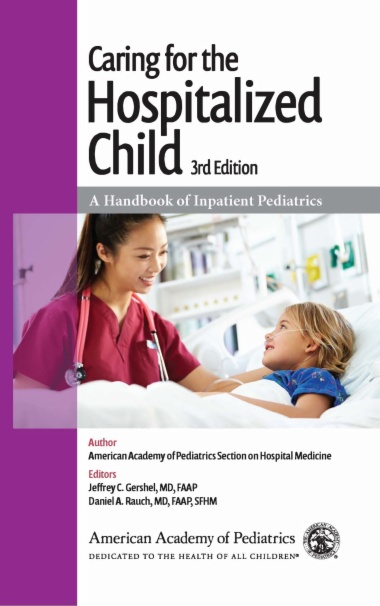Developed by top pediatric hospitalists, Caring for the Hospitalized Child: A Handbook of Inpatient Pediatrics, 3rd Edition, is sure to become your go-to resource from initial patient evaluation all the way through discharge management. Quickly obtain the essential information for managing a wide range of pediatric medical conditions in patients who have been admitted to the hospital with this trusted, pocket-sized reference.
Each chapter not only discusses clinical presentation, essential laboratory tests, differential diagnosis, treatment, indications for consultation, and disposition but contains many helpful tables and an easy-to-follow template. Chapters also include a short bulleted list of essential pearls and pitfalls. Although the book focuses primarily on diseases and conditions, it contains helpful sections that address the many other issues practicing hospitalists are confronted with, including ethics, billing, utilization management, surge planning, and transport, as well as a brief section on common equipment.
The alphabetized Contents has been updated to include Autism Spectrum Disorder, Hypertension, Constipation, Surge Planning, Utilization Management, and both Acute COVID-19 Disease and Multisystem Inflammatory Syndrome in Children (MIS-C). A new part on newborn care has been added, covering topics such as breastfeeding, hypoglycemia of the newborn, and early onset sepsis.
- Front Matter
- Adolescent
- 1. Anovulatory Uterine Bleeding
- 2. Eating Disorders
- 3. Sexually Transmitted Infections
- Allergy
- Behavioral and Mental Health
- 5. Acute Agitation
- 6. Autism Spectrum Disorder
- 7. Depression
- 8. Suicide and Self-Harm
- Cardiology
- 9. Arrhythmias and Electrocardiogram Interpretation
- 10. Carditis: Endocarditis, Myocarditis, and Pericarditis
- 11. Congestive Heart Failure
- 12. Hypertension
- 13. Shock
- 14. Syncope
- Dermatology
- 15. Erythema Multiforme, Stevens-Johnson Syndrome/Toxic Epidermal Necrolysis, and Mycoplasma pneumonia–Induced Rash and Mucositis
- 16. Rashes Associated With Serious Underlying Disease
- 17. Skin and Soft-Tissue Infections
- Ear, Nose, Throat
- 18. Mastoiditis
- 19. Neck Masses
- 20. Orbital and Periorbital Cellulitis
- 21. Peritonsillar and Retropharyngeal Abscesses
- 22. Sinusitis
- 23. Stridor
- Endocrinology
- 24. Acute Adrenal Insufficiency
- 25. Diabetes, Diabetic Ketoacidosis, and Type 2 Diabetes
- 26. Diabetes Insipidus
- 27. Hyperthyroidism
- 28. Hypoglycemia
- Equipment
- 29. Feeding Tubes
- 30. Lines and Pumps
- Ethics and Palliative Care
- 31. Do Not Resuscitate/Do Not Intubate
- 32. Informed Consent, Assent, and Confidentiality
- 33. Palliative Care
- Gastroenterology
- 34. Acute Hepatitis
- 35. Constipation
- 36. Failure to Thrive
- 37. Gallbladder Disease
- 38. Gastroenteritis
- 39. Gastrointestinal Bleeding
- 40. Inflammatory Bowel Disease
- 41. Pancreatitis
- Hospitalist Practice
- 50. Billing
- 51. Cultural Effectiveness
- 52. Patient Safety
- 53. Surge Planning
- 54. Transport
- 55. Utilization Management
- Immunology and Rheumatology
- 56. Arthritis Associated With Systemic Disease
- 57. Henoch-Schönlein Purpura (Immunoglobulin A Vasculitis)
- 58. Immunodeficiency
- 59. Kawasaki Disease
- 60. Systemic Lupus Erythematosus
- Infectious Disease
- 61. Acute COVID-19 Disease
- 62. Fever in Infants Younger Than 60 Days
- 63. Fever in the International Traveler
- 64. Fever of Unknown Origin
- 65. Multisystem Inflammatory Syndrome in Children (MIS-C)
- 66. Sepsis
- Ingestions
- 67. Gastrointestinal Foreign Body
- 68. Toxic Exposures
- Maltreatment
- 69. Child Abuse: Physical Abuse and Neglect
- 70. Sexual Abuse
- Nephrology
- 71. Acute Glomerulonephritis
- 72. Hemolytic Uremic Syndrome
- 73. Nephrolithiasis
- 74. Nephrotic Syndrome
- 75. Pyelonephritis
- Neurology
- 76. Acute Hemiparesis
- 77. Acute Weakness
- 78. Altered Mental Status
- 79. Cerebrospinal Fluid Shunt Complications
- 80. Demyelinating Disorders
- 81. Headache
- 82. Seizures
- Newborn Care
- 83. Breastfeeding
- 84. Early-Onset Sepsis
- 85. Hypoglycemia of the Newborn
- 86. Late Preterm Infants
- 87. Neonatal Abstinence (Withdrawal)Syndrome
- 88. Neonatal Hyperbilirubinemia
- Nutrition
- 89. Fluids and Electrolytes
- 90. Obesity
- Ophthalmology
- 91. Ocular Trauma
- 92. Red Eye
- Orthopedics
- 93. Fractures
- 94. Osteomyelitis and Septic Arthritis
- Pulmonology
- 95. Acute Asthma Exacerbation
- 96. Acute Respiratory Failure
- 97. Airway Management and Respiratory Support
- 98. Brief Resolved Unexplained Events
- 99. Bronchiolitis
- 100. Community-Acquired Pneumonia
- 101. Complications of Cystic Fibrosis
- 102. Foreign Body Aspiration
- Sedation and Analgesia
- 103. Pain Management
- 104. Sedation
- Surgery
- 105. Abdominal Masses
- 106. Acute Abdomen
- 107. Pyloric Stenosis
- 108. Wound Care Basics
- Index

